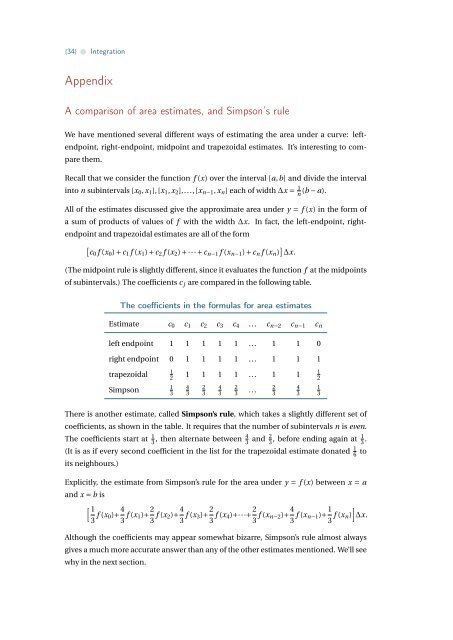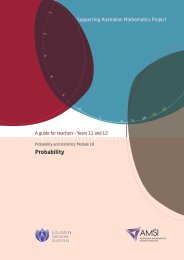Integration - the Australian Mathematical Sciences Institute
Integration - the Australian Mathematical Sciences Institute
Integration - the Australian Mathematical Sciences Institute
You also want an ePaper? Increase the reach of your titles
YUMPU automatically turns print PDFs into web optimized ePapers that Google loves.
{34} • <strong>Integration</strong>AppendixA comparison of area estimates, and Simpson’s ruleWe have mentioned several different ways of estimating <strong>the</strong> area under a curve: leftendpoint,right-endpoint, midpoint and trapezoidal estimates. It’s interesting to compare<strong>the</strong>m.Recall that we consider <strong>the</strong> function f (x) over <strong>the</strong> interval [a,b] and divide <strong>the</strong> intervalinto n subintervals [x 0 , x 1 ],[x 1 , x 2 ],...,[x n−1 , x n ] each of width ∆x = 1 n(b − a).All of <strong>the</strong> estimates discussed give <strong>the</strong> approximate area under y = f (x) in <strong>the</strong> form ofa sum of products of values of f with <strong>the</strong> width ∆x. In fact, <strong>the</strong> left-endpoint, rightendpointand trapezoidal estimates are all of <strong>the</strong> form[c0 f (x 0 ) + c 1 f (x 1 ) + c 2 f (x 2 ) + ··· + c n−1 f (x n−1 ) + c n f (x n ) ] ∆x.(The midpoint rule is slightly different, since it evaluates <strong>the</strong> function f at <strong>the</strong> midpointsof subintervals.) The coefficients c j are compared in <strong>the</strong> following table.The coefficients in <strong>the</strong> formulas for area estimatesEstimate c 0 c 1 c 2 c 3 c 4 ... c n−2 c n−1 c nleft endpoint 1 1 1 1 1 ... 1 1 0right endpoint 0 1 1 1 1 ... 1 1 1trapezoidalSimpson121 1 1 1 ... 1 11343234323...23431213There is ano<strong>the</strong>r estimate, called Simpson’s rule, which takes a slightly different set ofcoefficients, as shown in <strong>the</strong> table. It requires that <strong>the</strong> number of subintervals n is even.The coefficients start at 1 3 , <strong>the</strong>n alternate between 4 3 and 2 3 , before ending again at 1 3 .(It is as if every second coefficient in <strong>the</strong> list for <strong>the</strong> trapezoidal estimate donated 1 6 toits neighbours.)Explicitly, <strong>the</strong> estimate from Simpson’s rule for <strong>the</strong> area under y = f (x) between x = aand x = b is[ 13 f (x 0)+ 4 3 f (x 1)+ 2 3 f (x 2)+ 4 3 f (x 3)+ 2 3 f (x 4)+···+ 2 3 f (x n−2)+ 4 3 f (x n−1)+ 1 3 f (x n)]∆x.Although <strong>the</strong> coefficients may appear somewhat bizarre, Simpson’s rule almost alwaysgives a much more accurate answer than any of <strong>the</strong> o<strong>the</strong>r estimates mentioned. We’ll seewhy in <strong>the</strong> next section.
















